Kettlebells USA Paradigm Pro Elite Precision Review

As I’ve progressed in my kettlebell training I’ve found myself moving away from cast-iron kettlebells and toward competition steel kettlebells. I have no interest in competing, but I’m finding the consistent size of competition-style kettlebells is allowing me to more easily transition between kettlebells of different weights. I’ve been working with two Paradigm Pro Elite Kettlebells from Kettlebells USA for several months, and I’m ready to document my thoughts on them. Are they worth investing in for your home gym? Read on!
Intro
Previously, Paradigm Pro Elite Precision kettlebells were only available with a handle diameter of 35mm. For people like myself with small-to-medium sized hands, a smaller handle diameter is preferable because it helps reduce grip fatigue. In the past the only other handle diameter option Kettlebells USA offered was the Paradigm Pro Classic line of kettlebells, which have a 33mm handle diameter. However, the Classic line is an older design that was superseded with the introduction of the Paradigm Pro Elites.
Thankfully, Kettlebells USA recently introduced a version of the Paradigm Pro Elite Precision kettlebells with a 33mm handle diameter.
I own two Paradigm Pro Elite kettlebells – one 16kg with a 33mm handle and one 20kg with a 35mm handle. I’ve been using both over the last few months, and although a 2mm delta doesn’t seem like much I can confirm it does have an impact on training. I’ll cover this aspect in more detail in the Usability section.
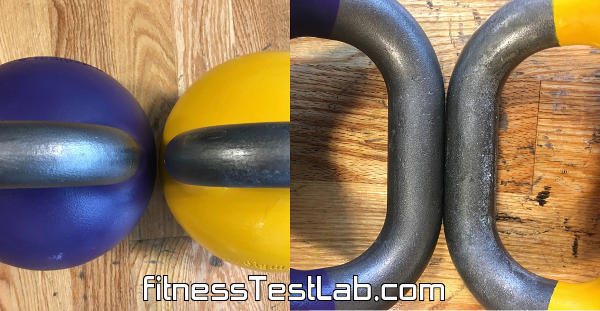
20kg (purple) with 35mm handle vs 16kg (yellow) with 33mm handle
Unboxing
The 16kg Paradigm Pro Elite kettlebell was shipped on a Monday from California and was delivered to me in Austin Texas by the following Thursday. Not bad, considering it had to travel halfway across the country.
The 16kg kettlebell was extremely well packed, with a Kettlebells USA sticker placed right on top. Competition kettlebells in general tend to be more carefully packed than their cast-iron counterparts, but the Paradigm Pros are the only ones I’ve seen so far to include no less than four separate reinforcement straps to protect the integrity of the box. I think it would take a lot to damage the box and the kettlebell inside it. Not saying it never happens, just that it would take a lot of mishandling to do it.
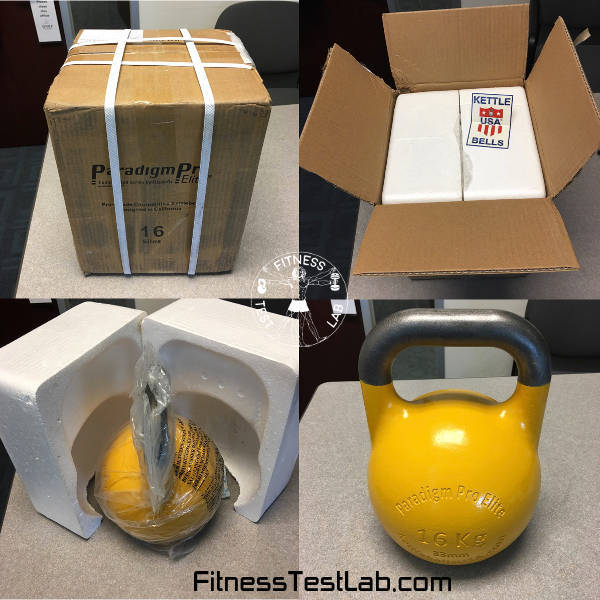
The 16kg kettlebell unboxed
I don’t have unboxing notes for the 20kg because I received it second-hand, but I’ve no reason to expect the packaging or shipping speed to be any different from the 16kg.
Impressions
The first thing I noticed about the Paradigm Pro Elite kettlebells was the pitted steel finish, especially on the handle. Many competition-style kettlebells have a smooth bare metal finish on the handle, which makes the pitted finish of the Paradigm Pro Elite stand out. My initial thought was the pitting might provide more grip than a smooth finish, thus reducing the need for chalk. More on that later.
The paint job on these kettlebells is also notable because the paint is completely flush with the metal rather than baked on as a separate layer. Enamel paint doesn’t typically bind to stainless steel very well, which means it has the potential to chip off fairly easily.
According to Kettlebells USA, the paint process used for the Paradigm Pro Elites is a multi-layered proprietary procedure that uses high quality paint applied in a spray booth and then treated for longevity. The special paint process combined with the pitted finish definitely results in more paint being bonded to the steel.

Paradigm Pro Elite Precision 20kg, 35mm handle
A clear coat of paint is often applied to the bare metal handle of a competition-style kettlebell to protect it against rust during shipment, which requires removal by sanding or chemical stripping before use. This doesn’t seem to be an issue for the Paradigm Pro Elite kettlebells. The handle is not painted with any kind of clear coat, so the kettlebells are ready to use right out of the box.
Test plan
I’ve been using the Paradigm Pro Elite Precision kettlebells for the last three months during meets of my office kettlebell club. We meet twice a week and go through various kettlebell complexes that include a mix of one-hand and two-hand work. I also use these kettlebells twice more per week for solo work. I use the 20kg exclusively for two-hand work and I’ve alternated between the 16kg and 20kg for one-hand work during the test period. The complexes we do during club meets vary, but they all consists of five rounds of at least 5-8 exercises from the following list:
- Two-hand swings
- One-hand swings
- Snatches
- Cleans with overhead press
- Windmills
- Rack squats
- Figure eights
- Lunges
- Turkish get-ups
- High pulls
- Rows
- One-legged deadlifts
- Two-legged deadlifts
- Halos
- Goblet squats

Paradigm Pro Elite Precision 16kg, 33mm handle
Usability
I need to be able to work with the kettlebell for extended periods without resorting to using chalk for the sake of keeping my house and work gym clean. The quality of finish and coating are the biggest factors that impact my ability to hold on to the bell without needing chalk.
Unlike cast-iron kettlebells, the handles of competition-style kettlebells are not finished with any type of coating, not counting the typical protective clear paint that gets removed before use. A coating like an e-coat or powder coat helps protect the metal from rust, but also helps maintain grip.
Without a coating, there’s no getting around the fact that a bare steel handle will get slippery once your hands start sweating. Some amount of chalk use will be necessary.
Having said that, the pitted handle of the Paradigm Pro Elite kettlebells does provide more grip than a bare steel handle and I find I can use it for kettlebell club sessions with minimal chalk use. When I do need to resort to chalk, I’ve found that a climbing chalk ball kept in a zip-lock bag works well for keeping my hands dry and grippy with minimal mess.
For those interested in kettlebell sport, you’ll be pleased to know the pitted handle hand of the Paradigm Pro Elites can hold a lot of chalk. These kettlebells are nicknamed “chalk gobblers”, and for good reason:
Although I can and do work with the 35mm handle on the 20kg kettlebell, I much prefer the 33mm handle of the 16kg. I realize it’s hard to compare apples to apples since the two kettlebells are different weights, but I can definitely tell my grip is stronger when using the 16kg with the 33mm handle. For those with larger hands, the 35mm handle will likely be the best option.
The last point worth mentioning is the handle window width. At 125mm (approximately 4.9 inches) wide, the windows provides just enough space to accommodate two hands for swings, provided your hands aren’t extra large. The handle window is also very comfortable for hand insertion and transitions during snatches and cleans.
Durability
The kettlebell needs to hold up to constant use, and occasional accidental misuse for those rare times when a bell gets dropped due to grip fatigue or a failed rep.
Paradigm Pro Elite Precision kettlebells are cast as a single piece of steel with a hollow core. This is significant because many competition kettlebells are constructed as a shell with filler material placed inside to make up the bulk of the weight. A base plate gets welded on the bottom of the shell to seal the weight inside.As a result, the bulk of weight ends up in the base of the kettlebell and there is potential for pieces of the filler material to break loose inside the shell. This is a common problem with lower quality kettlebells, which can rattle when filler material starts to break loose.
Update – Kennedy Miller from Kettlebells USA read this review and was kind enough to offer details on how hollow core kettlebells are made. The process is referred to as “Inner Core Technology”, which was pioneered by Kettlebells USA and introduced to the US market in 2014.
To summarize, very find sand is heated to an extremely high temperature in the shape of the kettlebell core. The high temperature fuses the sand into a mold that can be used to shape the molten steel that will eventually form the kettlebell body. After the steel for the kettlebell is poured and cooled, the sand is removed leaving the inside of the kettlebell hollow.
The single-cast design of the Paradigm Pro Elite provides a more balanced weight distribution and therefore a more balanced load displacement when working with the kettlebell. By extension, the kettlebell is easer to work with for prolonged periods of time.
If you look closely at the pictures of the kettlebell molds you’ll see a steel bar extending through the middle of the mold. The intent of the bar is to support the inner core and the mold during the fabrication process. The support bar remains intact after the kettlebell is formed and the sand mold is removed.
If you tip a Paradigm Pro Elite kettlebell on its side you’ll see a hole in the bottom. The support bar can be seen inside that extends across the center of the kettlebell, which I’ve not seen in other kettlebells that utilize a hollow core design.
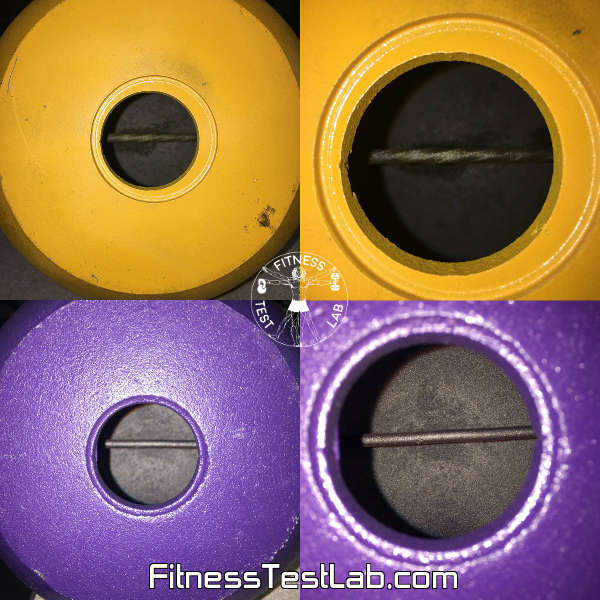
Hollow core design with support bar across the middle
The paint finish I referred to in the Impressions sections is very durable. I’ve not seen any chips in the paint in either kettlebell after continued use over the last few months, even though I’ve taken no special care to protect them from damage. They still look almost brand new after several months of hard use. I’ve no doubt these kettlebells will last me for as long as I care to use them.
Along with the information on how the Paradigm Pro Elite Precision kettlebells are made, Kennedy provided the following information which I pass on to you:
Perhaps of interest, our products are produced at a ISO 9001 certified foundry that casts automotive parts and elevator components. The craftsmen who finish our products are extremely high skilled and each Paradigm Pro Elite bell requires over 10 man hours to prepare from breaking the mold to make ready for painting and packaging.
Price
I’m not necessarily looking for the absolute cheapest option, I want the best product I can afford that meets my need. I weigh quality against cost with the understanding that price is not always reflective of quality level.
At the time of this writeup the combined price of a 16kg and 20kg Paradigm Pro Elite Precision plus tax and free shipping is $216.50. The price is the same for the 33mm and 35mm handle versions.
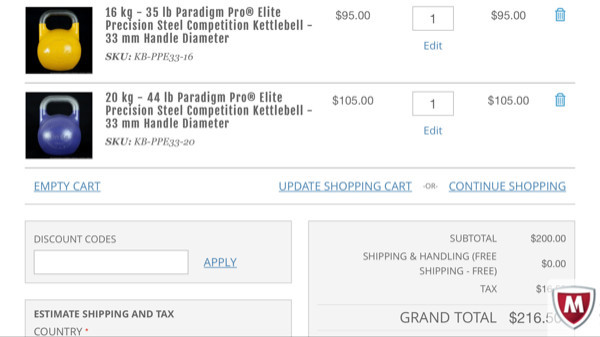
Paradigm Pro Elite Precision Price
For comparison, the price of two equivalent weight cast-iron Metrixx Elite Precision E-Coat kettlebells is $205.68.
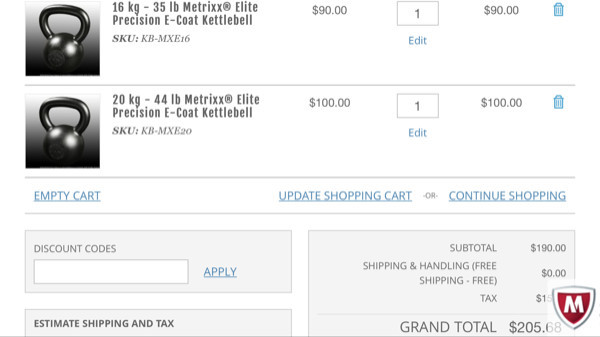
Metrixx Elite Precision E-Coat Price
The prices may vary over time, so you may see a different price when you eventually read this. However, the price difference isn’t huge, and at just $11 more the Paradigm Pro Elite Precision kettlebells are a no-brainer as long as your home gym setup can tolerate a small amount of chalk use.
Pros
The introduction of a 33mm handle diameter in the Paradigm Pro Elite Precision kettlebell line is a welcome change for those of us with smaller hands. I also very much like the pitted steel finish since it provides more grip than a smooth bare metal finish. The pitted finish also holds a lot of chalk in case that’s an important factor for you.
Cons
Even though the handle is pitted, the Paradigm Pro Elite Precision kettlebells are most definitely intended for kettlebell sport. This means the handle is not coated in any way, which also means some chalk is going to be needed. Although I can’t make a big chalk mess at home, I’ve learned to accept a small amount of chalk use since I like the advantages that consistently-sized kettlebells offer. I also want to note that competition-sized kettlebells take up more storage space than their equivalent weight cast-iron counterparts.
To be fair, neither of these cons is specific to the Paradigm Pro Elite kettlebells – they apply to all competition-style kettlebells. I only point them out so you know what you’re in for if you decide to buy competition-style kettlebells.
Verdict

The Paradigm Pro Elite Precision kettlebells are a five star product. They are an excellent choice whether you practice kettlebell sport or just need solid kettlebells for your home gym. If you’re on the fence about buying these, just buy them. You won’t regret it. The only real decision you need to make is whether to go with a 33mm or 35mm handle.
For men and women 5’10” and under with small-to-medium sized hands, I recommend the 33mm version. For taller folks or people with large hands, go with the 35mm version.
I hope you’ve found this review helpful. If you have any questions I didn’t cover in the review, post them in the comments below and I’ll do my best to answer them.
About the Author Mario
I'm a software product manager with a full-time job, family, and a desire to stay strong, mobile, and fit. I separate fact from fiction to find the most effective and affordable options for home fitness. If you'd like to build your own home gym, start here.
Popular posts
Session expired
Please log in again. The login page will open in a new tab. After logging in you can close it and return to this page.

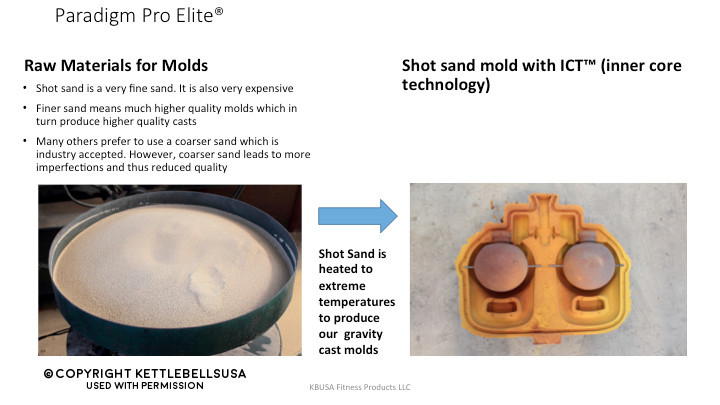

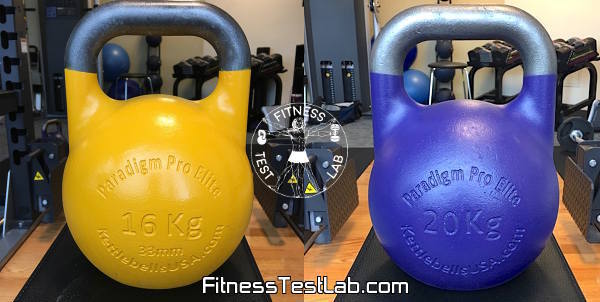
I have seen some comments around the web mentioning the rod I see in the middle of the bell causing vibration during lifting, I even saw where the engineer equated it to a church bell on another review, have you experienced this during lifting? I also noticed on ads for these bells the rod does not appear to be there, do you know which it is?
Hi Jacob, the Paradigm Pro Elites that I own both have the rod inside. I’ve not had any issues with vibration when using either of them.
Hi Mario,
How are these bells for two-handed swings compared to Kettlebell Kings competition bells and Vulcan Absolute Training bells? I see that both are reviewed on your website.
-Varun
The Vulcan Absolute Training kettlebell is the best for two-hand swings, with the KBUSA kettlebells coming in a very close second. There is literally a 2mm of interior width difference between them, which is barely noticeable. The Kettlebell Kings comp bells are great bells, but mainly designed for one hand use and therefore the handle window is significantly narrower.